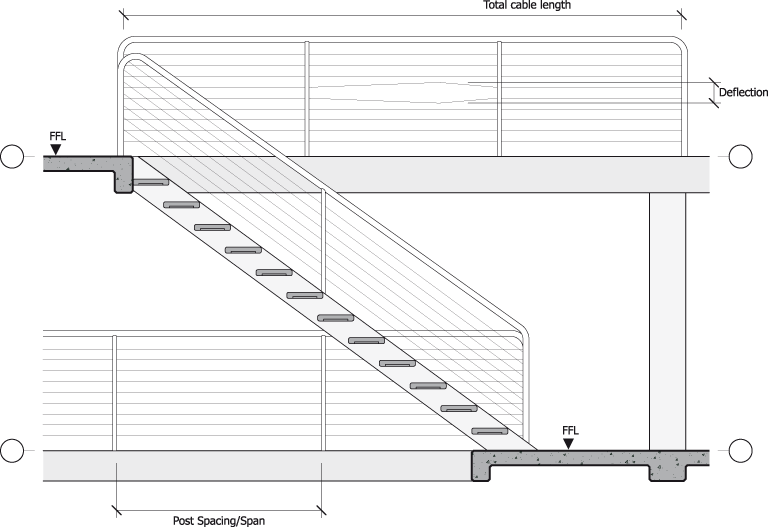
This primary consideration is driven by a combination of aesthetics and building regulations. Some codes prohibit the application of horizontal cables where a finished floor height is a specified distance above ground. We recommend you review the regulations in your region or country before making your selection.
Aesthetics and structural integrity are the driving considerations when selecting posts.
End posts must be adequately designed to cope with the loads necessary to resist cable deflection when forces are applied. This involves a careful selection of materials and in some instances requires the involvement of your project consultants.
Lighter construction intermediate posts can be located to hold horizontal cables in position and limit deflection by minimising the free span, rather than increasing tension in the cables and/or upsizing the end posts.
The span or distance between posts on a balustrade/railing has a direct relationship to deflection. With increased spacings higher tension needs to be applied to resist deflection. Often keeping your posts closer together to limit deflection is more economical and aesthetically pleasing than increasing the strength of end posts to cope with higher tensile loads.
Some building codes now require cables to be installed in accordance with specific tension/spacing and maximum allowable deflection requirements.
Along with aesthetics, cable stretch is a key consideration when selecting a diameter. As the diameter increases, so does the cable’s resistance to elongation and deflection at a given load.
Generally, 3mm or 1/8” cables provide an optimal combination of strength, stretch, resistance to defection, aesthetics and economy. In some countries, such as the USA, 5mm or 3/16” cable diameter is preferable for code compliance.
Cable construction refers to the number and lay of individual wires within the cable. Two constructions are specified for Ronstan balustrade and railing applications.

1×19 offers the lowest stretch over long distances. It has smooth outer strand and a technical appearance.

7×7 is a more flexible cable with a textured or braided appearance. It is superior for applications with multiple changes of cable direction, but is limited to shorter distances by its higher stretch.
Grade 316 is widely considered the default stainless steel grade for balustrade cables. It offers the best marriage of corrosion resistance and strength which is critical to aesthetics and structural performance over time.
Understanding that cables deflect, cable spacing has a direct impact on the ability of infill cables to restrict the passage of minimum sized objects through the balustrade/railing as required by local authorities and codes. Typically, spacings of 80-100mm (3-4”) are used, however, local requirements vary considerably and we recommend consultation with your local building authority.
A good practise is to design cable spacings closer than the local code requires allowing for some cable deflection. We commonly see cable spacings 25mm (1”) closer than mandated by regulatory codes.
Stainless steel cables are high tensile tendons used to transfer load between two points. If a load is applied at any point along the cable it will deflect. In the case of balustrade or railing cables, deflection becomes an issue of safety allowing the passage of items through the balustrade or railing. Deflection bears close relationship to cable diameter, cable construction, cable spacing, post spacing/span, cable tension and cable length.

Stainless Steel – Ronstan understand the benefits afforded by stainless steel cable balustrades and railing. Clean crisp aesthetics, low maintenance and structural integrity can only be guaranteed through the use of quality material and known quality assured manufacture. Ronstan cable systems are manufactured to ISO9001-2000, they are load rated and designed specifically for balustrade and railing applications. Our material is fully traceable, our systems simple and connections reliable. Ronstan manufactured cable systems are denoted by the ![]() code. Ronstan connectors can be used on either metal or timber posts. Our ABS systems can handle any detail situation with the use of our specialist components located in the components section.
code. Ronstan connectors can be used on either metal or timber posts. Our ABS systems can handle any detail situation with the use of our specialist components located in the components section.

The ‘commodity’ grade fittings (see RONSTAN RIGGING COMPONENTS in the PRODUCT menu) are commonly used for budget applications where price is the driving consideration rather than quality or performance. The commodity grade range offers an economic non-rated solution with fittings subject to dimensional changes without notice.
Commodity grade fittings are denoted by the ![]() code.
code.